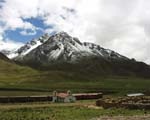 Abra de Raya pass
Abra de Raya pass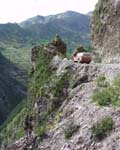
Fresh air on the Pisac medal section
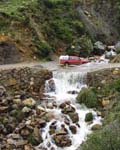
One of the many watersplashes (but they will be much drier in October)
 Abra de Raya pass Abra de Raya pass |
 Fresh air on the Pisac medal section |
 One of the many watersplashes (but they will be much drier in October) |
Day 30 - Saturday 19 February
A useful day in Cusco, noting the routes into and out of the city and catching up with paperwork while Jingers gave Mitzi a good fettle. We didn't find the time we'd hoped for, to make proper tourist visits to either the main Inca site of Sacsayhuaman or the 16th century cathedral, whose sumptuous interior I recall from my last visit to be full of fine paintings and great altars covered with Inca gold.
We do however revisit the Plaza de Armas, one of the finest town squares in the Americas - the Alcalde, or mayor, has promised me that this will be our arrival and restart control point.
We explore a few of the streets around. Cusco had been the Inca capital, and the Spaniards constructed their city on their street plan. Many of the colonial houses were built on Inca foundations of great irregular stones, placed against each other without mortar but so finely finished that you can't put a knife between them.
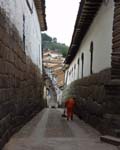
Colonial houses in Cusco, built on Inca foundations
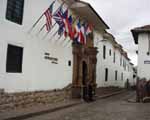
Hotel Monasterio, Cusco - one of the rally hotels
Day 31 - Sunday 20 February
The finest things in life are fully appreciated only if you have had to make an effort to attain them. This is certainly true of Machu Picchu. There is no road, so the only ways in are by a trek of several days, or by ultra-expensive helicopter, or by slow and rattly (if reasonably comfortable) train.
Today, we took a test drive of this, perhaps the highlight day of the whole Inca Trail. A very early start is called for as the train leaves at 06:00. It rises up out of the city in a series of switchbacks forwards then in reverse so as to cross into the valley of the Urubamba river, which it then follows downstream towards the Amazon through an ever-deepening gorge.
During the four-hour journey, there are a couple of halts en route to let other trains pass. We get out at a place called Aguas Calientes, or Hot Springs. From here, it is vertiginous 25-minute bus ride zigzags up the mountain face to the monument.
The setting alone is worth the ride: great deep gorges with near-vertical sides, wreathed in mists and green with jungle vegetation reminding us that we have descended to rain forest level.
Words cannot do justice to Machu Picchu itself. Like Petra or the Ngorongoro Crater, it is one of the world's handful of truly unforgettable places. No-one should miss it.
Two of the people on our train got back down to Aguas Calientes in time to take a dip in the hot baths. Very refreshing after all that strenuous climbing up and down the Inca streets and steps - I wish I'd known about it earlier.
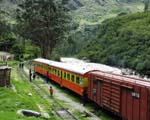
Train halt en route to Machu Picchu
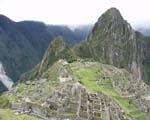
Machu Picchu
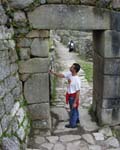
Jingers admires the city's main gate
Day 32 - Monday 21 February
German - pronounced Hair-man - has joined us today for the trip to Lima. He works for HIRCA, the travel agency who are helping us in Peru, and is keen to find out more about the obscurer corners of his own country. He has come to the right place.
With Jo as well, we are now four up and it is a tight squeeze, but German is great company and today has already earned his fare many times over with his knowledge of the country and its ways, and his ability to charm his (and our) way through barriers of all kinds.
We made good early start from Cusco, covering the first 150 km of excellent asphalt in about two and a half hours; then, wham!, the sort of thing that makes a nonsense of planned schedules: the road ahead was closed for three hours, thanks to a combination of landslips and major road works. A queue of vehicles has dug in for the duration, forming a sort of transit encampment, complete with soup kitchens set up by enterprising locals.
Landslips, I am discovering, are a major impediment to travel in the Andes during the rainy season, February being (naturally) the worst month. I am however relieved to be continually told that October is dry and the roads for the rally itself will be in their best condition.
This time, German quickly befriends the local police and persuades them that we are an official vehicle that must be allowed through as quickly as possible. They agree provided the site engineer gives the OK. A game then ensues of Hunt the Engineer, but at last he is tracked down and we are allowed to bump and squelch our way round various obstacles. We are now well late but the road works will at least take the asphalt almost as far as Abancay for the rally in 18 months' time.
I remember in 1969 passing through Abancay at night, going the other way; I saw its lights 65 km before I got there, and could still see them 35 km later. This time, the long climb up on good gravel - to be a spectacular regularity section - took us into cloud well before the 14,000 ft summit.
Having lost so much time, we have opted to spend the night in Andahuaylas, well short of our target of Ayacucho. It is raining hard.
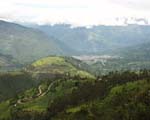
The road down to Abancay
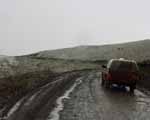
Summer in the tropics - at 14,000 ft!
Day 33 - Tuesday 22 February
This morning, two more major ascents to the 14,000 foot level, from valley floors of under 7,000 ft. The first took us up into a sprinkling of miserable sleety snow - this is summer in the tropics' The second, past Ocros, was an unforgettable zigzag climb straight up the enormous valley side - the granddaddy of uphill medal sections. We were briefly delayed while a bulldozer cleared yet another landslip.
Near the top, a primitive restaurant was preparing for tonight's local delicacy, sheep's head, by the simple expedient of decapitating a sheep. I suppose they cooked the rest, too. We decided not to reserve a table.
We arrived in Ayacucho in time to inspect the town's hotels - mostly basic but adequate for an overnight rally stopover - and for Jingers to screw a few bits back on to Mitzi. My first call was, as usual, at the town hall, where (despite having no appointment - just as well since we are a day late) we are warmly received by the Mayor's major domo, and promised such things as police assistance and the use of the main square for our arrival and restart controls and overnight parking. Everyone in these parts is enthusiastic about motor sport, and Ayacucho is an overnight halt for the annual Camino de los Incas road race around Peru, for which everything stops.
It is raining heavily again tonight.
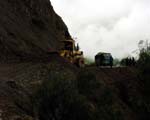
Bulldozer clearing landslide near Ocros; in the rainy season, bus timetables are clearly works of optimism round here
Next: Ayacucho to La Paz (to be posted Friday 24 March)